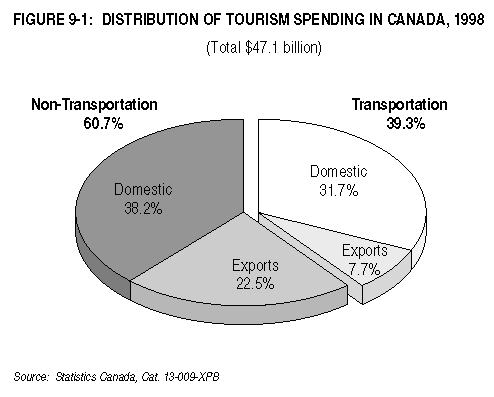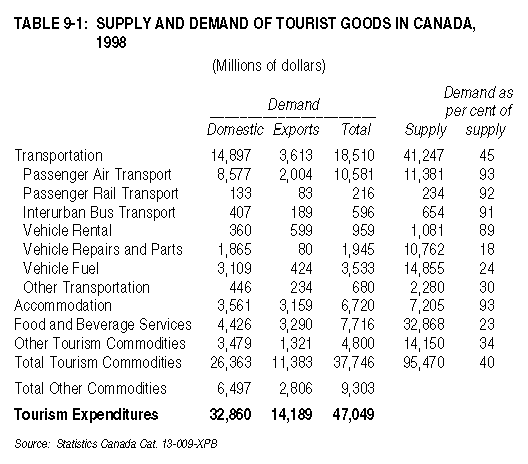9
TRANSPORTATION
AND TOURISM
Tourism Expenditures
Tourism Spending in Canada
Tourism spending in Canada is made up of spending by Canadians
and foreign visitors. Domestic demand refers to spending by Canadians
on tourism in Canada, as opposed to tourism exports, which refer
to expenditures made by foreign visitors in Canada. Tourism commodities
are those for which a significant amount of the demand comes from
tourism expenditures.
In 1998, tourism spending in Canada reached $47.1 billion,
up seven per cent from 1997. This growth continued in 1999, with
expenditures in the third quarter reaching $18.3 billion,
up six per cent from the same period in 1998. The relatively low
value of the Canadian dollar meant both more domestic tourism
and more international tourism expenditures in Canada.
Distribution of Spending
Figure 9-1 shows the distribution of tourism spending in Canada
for 1998. Canadians spent 70 per cent of the $47.1 billion
total expenditures on tourism, or $32.9 billion, while foreign
tourists spent 30 per cent. The foreign proportion of tourism
spending continued to increase in 1998, up from 25 per cent in
1994 and 29 per cent in 1997.

In the first three quarters of 1999, domestic demand strengthened
compared with foreign expenditures. During the third quarter of
1999, domestic tourism expenditures rose 6.1 per cent over the
same period in 1998, up from 3.5 per cent for the first quarter.
The rate of increase in foreign spending fell to 6.7 per cent
and 5.8 per cent for the second and third quarters of 1999, down
from the 10 to 13 per cent increases for the previous
five quarters.
Figure 9-2 shows the distribution of tourism spending on overnight
trips by non-residents in 1998. Tourism spending by this group
increased in all regions of Canada in 1998. In Quebec, however,
it rose only two per cent, compared with almost ten per cent or
more in the other regions. Overseas tourism spending fell in Quebec.
It also fell in Ontario and in Saskatchewan, where it has less
importance than US tourist expenditures. Spending by Americans
in Canada rose almost 15 per cent in both the Atlantic Provinces
and Quebec, and by more than 20 per cent in all other regions.
Overall, US residents accounted for 60 per cent of spending by
non-residents in Canada and 75 per cent of all trips in 1999,
up from 54 per cent and 72 per cent, respectively, in 1998.

Spending on Transportation
Tourism expenditures on transportation were $18.5 billion
in 1998, up five per cent from 1997 and accounting for 39 per cent
of all tourism spending in Canada. Of this amount, $10.6 billion,
or 57 per cent, was spent on air transportation, an eight per
cent increase from 1997. The other major spending category,
motor vehicle transportation, made up 35 per cent of the total
in 1998, compared with 37 per cent in 1997. This drop was due
to lower fuel prices. Intercity bus and rail transportation
remained unchanged from 1997, accounting for three per cent
and one per cent, respectively, of tourism spending on transportation.
Other forms of transportation spending, including water transport,
urban transit, taxi and parking, made up four per cent.
Figure 9-3 shows the quarterly distribution of tourist spending
on transportation from 1986 to 1999.

Supply and Demand
Table 9-1 shows demand and supply for tourist goods in Canada
in 1998, as presented in Statistics Canada's National Tourism
Indicators. Demand corresponds to expenditures on tourist goods,
while supply corresponds to the production of those goods.
The last column in Table 9-1 shows tourism spending (demand)
as a percentage of an industry's output (supply).

Tourism spending accounted for 45 per cent of all transportation
spending by consumers and businesses in 1998. It made up a high
proportion of expenditures for intercity transportation services
and a lesser amount for expenditures related to local travel.
Ninety-three percent of air transportation receipts resulted from
tourism spending. Similarly, a high proportion of spending for
rail transport, intercity buses and vehicle rentals were accounted
for by tourism. The proportion is much lower, around 20 per cent,
for local transportation, including the operation of individually
owned motor vehicles and spending on taxis and local transit,
which are included under "Other Transportation" in Table
9-1.
The Travel Account and International Passenger Fares
Travel Deficits
Canada's international travel account compares the value of
spending by foreigners travelling in Canada against the value
of spending by Canadians travelling outside Canada. A deficit
occurs when Canadians are spending more outside Canada than foreigners
are spending in Canada.
Figure 9-4 shows the trends in Canada's international travel
account from 1980 to 1999. Canada's travel deficit in 1999
was the smallest since 1987, falling by 6.2 per cent to $1.9
billion and continuing the decrease of 1998.

Canadians spent a total of $16.7 billion outside the country
in 1999, up 5.1 per cent from 1998. Foreign travellers spent $14.9
billion in Canada, a 6.7 per cent increase. Canadians travelling
to the US increased their spending by 6.5 per cent to $10.5 billion,
while Americans increased their spending in Canada by 5.4 per
cent to $9.1 billion. Canada's travel deficit with the US
rose 14.1 per cent to $1.4 billion, while the deficit
with other countries fell to $485 million. This is because
Canadians increased their overseas spending only by 2.7 per cent
to $6.2 billion and overseas visitors increased their expenditures
in Canada by 8.8 per cent to $5.7 billion.
International Passenger Fares
In 1999, Canadians purchased $3.73 billion worth of passenger
fares from foreign carriers. In turn, Canadian carriers sold $2.67
billion in passenger fares to foreign travellers, which left a
deficit of $1.06 billion in this account. Air fares accounted
for almost all these transactions. Canadians purchased $3.65 billion
in air fares from foreign carriers, while Canadian air carriers
sold $2.63 billion in air fares to foreign travellers. For land
transportation, Canadians spent $76 million on passenger fares
from foreign carriers, while foreign travellers spent $36 million
on fares from Canadian carriers. Passenger fares for water transportation
are included with air fares, and they represent an amount smaller
than those for land.
Tourism Expenditures
|

